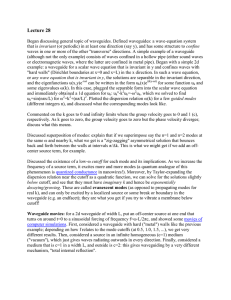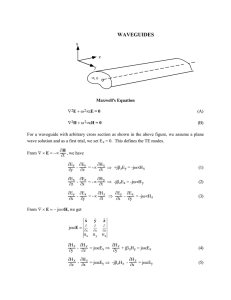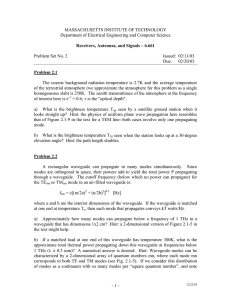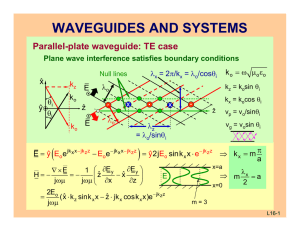CH12
advertisement
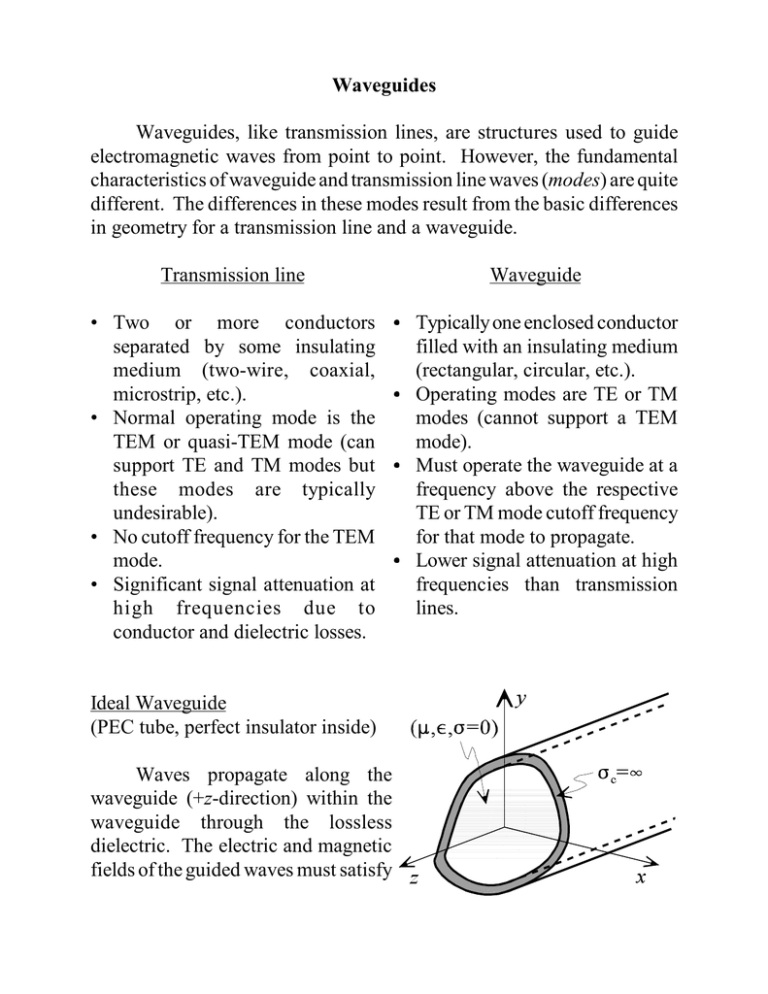
Waveguides Waveguides, like transmission lines, are structures used to guide electromagnetic waves from point to point. However, the fundamental characteristics of waveguide and transmission line waves (modes) are quite different. The differences in these modes result from the basic differences in geometry for a transmission line and a waveguide. Transmission line Waveguide • Two or more conductors separated by some insulating medium (two-wire, coaxial, microstrip, etc.). • Normal operating mode is the TEM or quasi-TEM mode (can support TE and TM modes but these modes are typically undesirable). • No cutoff frequency for the TEM mode. • Significant signal attenuation at high frequencies due to conductor and dielectric losses. C Typically one enclosed conductor Ideal Waveguide (PEC tube, perfect insulator inside) Waves propagate along the waveguide (+z-direction) within the waveguide through the lossless dielectric. The electric and magnetic fields of the guided waves must satisfy C C C filled with an insulating medium (rectangular, circular, etc.). Operating modes are TE or TM modes (cannot support a TEM mode). Must operate the waveguide at a frequency above the respective TE or TM mode cutoff frequency for that mode to propagate. Lower signal attenuation at high frequencies than transmission lines. the source-free Maxwell’s equations. Assumptions: (1) the waveguide is infinitely long, oriented along the z-axis, and uniform along its length. (2) the waveguide is constructed from ideal materials (enclosing PEC conductor is filled with a perfect insulator). (3) fields are time-harmonic. The electric and magnetic fields associated with the waves propagating inside the waveguide must satisfy the source free Maxwell’s equations given by These equations can be manipulated into wave equations for the electric and magnetic fields as was shown in the case of unguided waves. These wave equations are For certain waveguide geometries, the individual components of the fields can be determined using the separation of variables technique. For a wave propagating along the waveguide in the z-direction, the electric and magnetic fields may be written in rectangular coordinates as The constant ( is the waveguide propagation constant defined by where " is the waveguide attenuation constant and $ is the waveguide phase constant. In general, the waveguide propagation constant has very different characteristics than the transmission line propagation constant. The vectors es (x,y) and hs (x,y) in the waveguide field expressions may contain both transverse field components (ax, ay ) and longitudinal field components (az ). By expanding the curl operator of Maxwell’s equations in rectangular coordinates, and noting that the derivatives of the transverse components with respect to z can be evaluated as If we equate the vector components on each side of the two Maxwell curl equations, we find Equations (1) and (2) are valid for any wave (guided or unguided) propagating in the z-direction in a source-free region with a propagation constant of (. We may use Equations (1) and (2) to solve for the longitudinal field components in terms of the transverse field components. where the constant h is defined by The equations for the transverse fields in terms of the longitudinal fields describe the different types of possible modes for guided and unguided waves. Transverse electromagnetic (TEM) modes Ezs = Hzs = 0 plane waves, transmission lines Transverse electric (TE) modes Ezs ú 0, Hzs = 0 waveguide modes Transverse magnetic (TM) modes Ezs = 0, Hzs ú 0 waveguide modes Hybrid (EH or HE) modes Ezs ú 0, Hzs ú 0 waveguide modes For TEM modes, the only way for the transverse fields to be non-zero with Ezs = Hzs = 0 is for h = 0, which yields For the waveguide modes, h cannot be zero since this would yield unbounded results for the transverse fields. Thus, $ ú k and the waveguide propagation constant can be written as The ratio of h/k can be written in terms of the cutoff frequency fc for the given waveguide mode. The waveguide propagation constant in terms of the waveguide cutoff frequency is If f < fc, ( = " (purely real) e !( z = e !" z If f > fc, ( = j$ (purely imaginary) e!( z = e!j$ z waves are attenuated (evanescent modes). w a v e s a r e unattenuated (propagating modes). TE and TM Modes in Waveguides If the single non-zero longitudinal field component associated with a given waveguide mode (Hzs for a TE mode or Ezs for a TM mode) can be determined, the remaining transverse field components can be found using the general wave equations for the transverse fields in terms of the longitudinal fields. The longitudinal magnetic field of the TE mode and the longitudinal electric field of the TM mode are determined by solving the appropriate boundary value problem for the given waveguide geometry. General Waves TE Modes (Ezs = 0) TM Modes (Hzs = 0) Rectangular Waveguide The rectangular waveguide can support either TE or TM modes. The rectangular cross-section (a > b) allows for single-mode operation. Single -mode operation means that only one mode propagates in the waveguide over a given frequency range. A square waveguide cross-section does not allow for single-mode operation. Rectangular Waveguide TM modes The longitudinal electric field of the TM modes within the rectangular waveguide must satisfy the wave equation which expanded in rectangular coordinates is The electric field function may be determined using the separation of variables technique by assuming a solution of the form Inserting the assumed solution into the governing differential equation gives where h2 = (2 + k2. Dividing this equation by the assumed solution gives (1) Note that the first term in (1) is a function of x only while the second term is a function of y only. In order for (1) to be satisfied for every x and y within the waveguide, each of the first two terms in the equation must be constants. The original second order partial differential equation dependent on two variables has been separated into two second order pure differential equations each dependent on only one variable. The general solutions to the two separate differential equations are The resulting longitudinal electric field for the rectangular waveguide TM modes is The TM boundary conditions for the rectangular waveguide are The application of the boundary conditions yields The resulting product of the constants A and C into combined into one constant (Eo). The transverse field components of the TM modes are The index designation for the discrete TM modes is TMmn where (m = 1, 2, 3, ...) and (n = 1, 2, 3, ...). Rectangular Waveguide TE modes The longitudinal magnetic field of the TE modes within the rectangular waveguide must satisfy the same wave equation as the longitudinal electric field of the TM modes: which expanded in rectangular coordinates is The same separation of variables technique used to solve for the longitudinal TM electric field applies to the longitudinal TE magnetic field. Thus, the longitudinal TE magnetic field may be written as To determine the unknown coefficients, we apply the TE boundary conditions. The transverse electric field components are related to Hzs through the previously defined TE equations. The TE boundary conditions are: where The application of the boundary conditions yields Note that the case of n = m = 0 is not allowed since this would make all of the transverse field components zero. The resulting product of the constants B and D into combined into one constant (Ho) so that the longitudinal magnetic field of the TEmn mode is The resulting transverse fields for the waveguide TE modes are where (m = 0, 1, 2, ...) and (n = 0, 1, 2, ...) but m = n mode. ú 0 for the TEmn TE and TM Mode Parameters For both the TEmn and TMmn waveguide modes, we find that The equation for the waveguide propagation constant (mn can be used to determine the cutoff frequency for the respective waveguide mode. The propagation characteristics of the wave are defined by the relative sizes of the parameters hmn and k. The propagation constant for either the TEmn or TMmn waveguide modes is defined as (mn = "mn + j$mn If hmn = k Y (mn = 0 ("mn = $mn = 0) Y cutoff frequency If hmn > k Y (mn (real), [(mn= "mn] Y evanescent modes If hmn < k Y (mn (imag.), [(mn= j$mn] Y propagating modes Therefore, the cutoff frequency is found by solving The rectangular waveguide must be operated at a frequency above the cutoff frequency for the respective mode to propagate. As previously shown, the propagation constant for a given mode can be defined in terms of the cutoff frequency for that mode by The cutoff frequency of a particular mode in a particular rectangular waveguide depends on the mode indices (values of m and n), the geometry of the waveguide (a and b), and the medium inside the waveguide (: and ,). According to the cutoff frequency equation, the cutoff frequencies of both the TE10 and TE01 modes are less than that of the lowest order TM mode (TM11). Given a > b for the rectangular waveguide, the TE10 has the lowest cutoff frequency of any of the rectangular waveguide modes and is thus the dominant mode (the first to propagate). Note that the TE10 and TE01 modes are degenerate modes (modes with the same cutoff frequency) for a square waveguide. The rectangular waveguide allows one to operate at a frequency above the cutoff of the dominant TE10 mode but below that of the next highest mode to achieve single mode operation. A waveguide operating at a frequency where more than one mode propagates is said to be overmoded. The cutoff frequency and fields associated with the TE10 mode (using the TEmn equations with m =1, n = 0, and ( = j$ ) are: The corresponding instantaneous fields of the TE10 mode are determined by multiplying the phasor field components by e jT t and taking the real part of the result. The waveguide wavelength is defined using the same definition as for unguided (TEM) waves [2B/$]. However, the waveguide wavelength is very different than that of an unguided wave. The phase velocity of the TE and TM modes is Just as the characteristic (wave) impedance for the TEM modes on a transmission line is defined by a ratio of the transverse electric field to the transverse magnetic field, the wave impedance of the waveguide TE and TM modes can also be defined in a similar manner. The waveguide TE and TM wave impedances are defined by Waveguide Group Velocity and Phase Velocity The field components of general TE and TM waveguide modes can be written as sums and differences of TEM waves. Consider the Eys component of the TE10 mode of the rectangular waveguide: «®®®®®®®®®®®®®®®®®®®®®®®®®®­®®®®®®®®®®®®®®®®®®®®®®®®®¬ TEM waves uN ! medium velocity (velocity of the TEM wave) ug ! group velocity (velocity of the wave sum) up ! phase velocity (velocity of the constant phase points on the component waves) Example Given a pair of degenerate modes (TEnm and TMmn) in an air-filled rectangular waveguide with a cutoff frequency of 15 GHz, plot the following parameters as a function of frequency: phase velocity and group velocity, TE wave impedance and TM wave impedance, TEM wavelength and mode wavelength, TEM phase constant and mode phase constant. 3 2.5 2 u/u’ up 1.5 1 ug 0.5 0 0 10 20 30 f (GHz) 40 50 60 30 f (GHz) 40 50 60 3 2.5 2 η/ η’ ηTE 1.5 1 ηTM 0.5 0 0 10 20 5 4.5 4 3.5 λ (cm) 3 2.5 λmn 2 λ’ 1.5 1 0.5 0 0 10 20 30 f (GHz) 40 50 60 30 f (GHz) 40 50 60 12 10 -1 β (m ) 8 6 β’ 4 βmn 2 0 0 10 20 Cavity Resonators At high frequencies where waveguides are used, lumped element tuned circuits (RLC circuits) are very inefficient. As the element dimensions become comparable to the wavelength, unwanted radiation from the circuit occurs. Waveguide resonators are used in place of the lumped element RLC circuit to provide a tuned circuit at high frequencies. The rectangular waveguide resonator is basically a section of rectangular waveguide which is enclosed on both ends by conducting walls to form an enclosed conducting box. We assume the same cross-sectional dimensions as the rectangular waveguide (a,b) and define the longitudinal length of the resonator as c. Given the conducting walls on the ends of the waveguide, the resonator modes may be described by waveguide modes which are reflected back and forth within the resonator (+z and !z directions) to form standing waves. Waveguide (waves in one direction) Cavity (waves in both directions, standing waves) The separation equation for the cavity modes is The cavity boundary conditions are From the source-free Maxwell’s curl equations, the TE and TM boundary conditions on the end walls of the cavity are satisfied if Application of the TE and TM boundary conditions yields The TE and TM modes in the rectangular cavity are then The resonant frequency associated with the TEmnp or TMmnp mode is found from the separation equation to be The lowest order modes in a rectangular cavity are the TM110, TE101, and TE011 modes. Which of these modes is the dominant mode depends on the relative dimensions of the resonator. The quality factor (Q) of a waveguide resonator is defined the same way as that for an RLC network. where the energy lost per cycle is that energy dissipated in the form of heat in the cavity walls (ohmic losses). The resonator quality factor is inversely proportional to its bandwidth. Given a resonator made from a conductor such as copper or aluminum, the ohmic losses are very small and the quality factor is large (high Q, small bandwidth). Thus, resonators are used in applications such as oscillators, filters, and tuned amplifiers. Comparing the modes of the rectangular resonator with the propagating modes in the rectangular waveguide, we see that the waveguide modes exist over a wide band (the rectangular waveguide acts like a high-pass filter) while the rectangular resonator modes exist over a very narrow band (the rectangular resonator acts like a band-pass filter). Circular Waveguide The same techniques used to analyze the rectangular waveguide may be used to determine the modes that propagate within a circular waveguide. The separations of variables technique yields solutions for the propagating modes in terms of Bessel functions. One unique feature of the circular waveguide is that some of the higher order modes have particularly low loss. Therefore, this waveguide is commonly used when signals are sent over relatively long distances (microwave antennas on tall towers). Optical Fibers An optical fiber is a dielectric waveguide (lightguide) with a very high bandwidth and very low loss. The mechanism of wave propagation on an optical fiber is very different than that of a metal waveguide. The optical fiber confines the propagating wave inside the fiber by utilizing reflection of the light waves from a dielectric interface formed by the core (inner dielectric) and the cladding (outer dielectric). Visible light (0.4 :m < 8 < 0.7 :m) Typical optical fiber dimensions Glass fibers (low loss) Core diameter Cladding diameter 10 to 50 :m 125 :m Plastic fibers Core diameter Cladding diameter ~1000 :m 2000 to 3000 :m f ~ 1014 Hz Step-Index (STIN) Fibers Graded-Index (GRIN) Fibers


